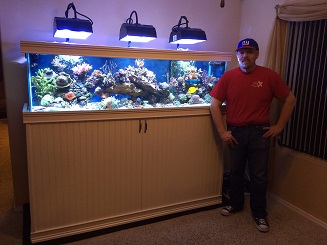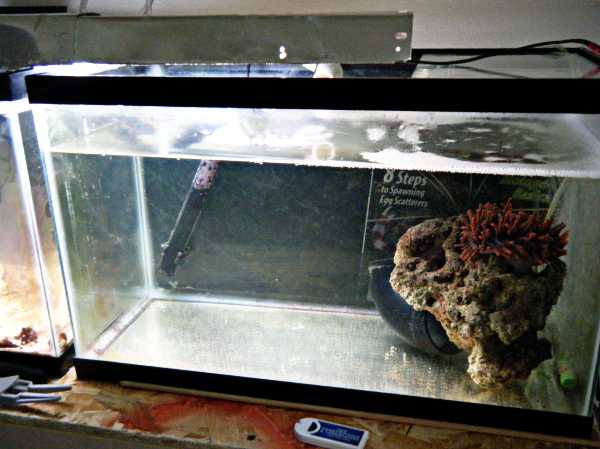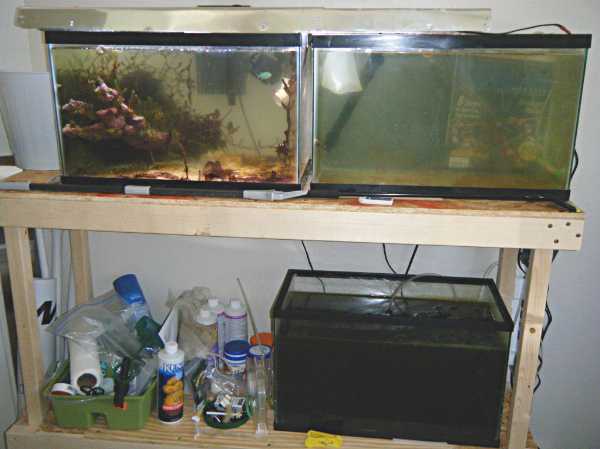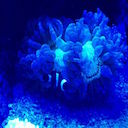| Author |
 Topic Search Topic Search  Topic Options Topic Options
|
ptronsp 
Guest


Joined: November 09 2010
Location: St.George
Status: Offline
Points: 2080
|
 Post Options Post Options
 Thanks(0) Thanks(0)
 Quote Quote  Reply Reply
 Posted: May 15 2011 at 7:14pm Posted: May 15 2011 at 7:14pm |
Good job!  It is so exciting watching them get bigger and watching them get their color isn't it? Question... why do you keep your rotifers so dark? Pam
|
 |
Mark Peterson 
Paid Member


Joined: June 19 2002
Location: Murray
Status: Offline
Points: 21436
|
 Post Options Post Options
 Thanks(0) Thanks(0)
 Quote Quote  Reply Reply
 Posted: May 15 2011 at 7:45pm Posted: May 15 2011 at 7:45pm |
Well, being away for a week was almost unbearable - wondering if everything is okay and how they look. It was a big difference to see them as larvae with just a little color, but mostly black splotches before we left to real orange and white clownfish when we returned.  This is what happened 10 years ago when I did it the first time. I left my daughter in charge of them while we went on a vacation.  Dark green Rotifer culture? I like to have them full of phyto for the babies to eat. When I can see the bottom frame of the other side of the Rotifer tank, I know it's time to feed them more algae paste. How do you do it?
|
Reefkeeping Tips, & quick, easy setup tricks:www.utahreefs.com/forum/forum_posts.asp?TID=9244 Pay it forward - become a paid WMAS member 
|
 |
ptronsp 
Guest


Joined: November 09 2010
Location: St.George
Status: Offline
Points: 2080
|
 Post Options Post Options
 Thanks(0) Thanks(0)
 Quote Quote  Reply Reply
 Posted: May 15 2011 at 9:54pm Posted: May 15 2011 at 9:54pm |
|
Dark green Rotifer culture? I like to have them full of phyto for the babies to eat. When I can see the bottom frame of the other side of the Rotifer tank, I know it's time to feed them more algae paste. How do you do it?
[/QUOTE]
I keep my rotifers in 2 5 gallon buckets and I keep them green as well but not nearly as dark. Once the rotifers clear I know to add more :).
Pam
|
 |
Mark Peterson 
Paid Member


Joined: June 19 2002
Location: Murray
Status: Offline
Points: 21436
|
 Post Options Post Options
 Thanks(0) Thanks(0)
 Quote Quote  Reply Reply
 Posted: May 16 2011 at 8:11am Posted: May 16 2011 at 8:11am |
|
More food ensures a denser population. This has been useful for when I have many mouths to feed and still have enough to share with other hobbyists.
|
Reefkeeping Tips, & quick, easy setup tricks:www.utahreefs.com/forum/forum_posts.asp?TID=9244 Pay it forward - become a paid WMAS member 
|
 |
BobC63 
Admin Group


Joined: January 17 2007
Location: Lehi, UT
Status: Offline
Points: 8971
|
 Post Options Post Options
 Thanks(0) Thanks(0)
 Quote Quote  Reply Reply
 Posted: May 16 2011 at 8:40am Posted: May 16 2011 at 8:40am |
Hey guys -
I don't know much about raising clown babies, but I read through this and was thinking about the water quality questions, and the mortality issues that may have been at least partly blamed on water quality...
I was thinking perhaps a setup similar to the one I used when raising my Banggai babies might prove helpful; the one where I basically set up a 10g 'nursery' tank right next to the display and used a simple siphon tube to bring water from the display into the nursery - and a small powerhead to move water back into the main tank.
You would need to modify somewhat (probably not run the powerhead constantly to avoid removing all the rotifers, etc out of the nursery water column; a sponge filter over the p-head intake to avoid sucking in fry) but my thought is that this will mean a fairly constant inflow of clean tank water that has all the exact same parameters as the water the eggs were laid in.
Also eliminates the need for water changes within the nursery tank - and the resulting fluctuations in parameters that may be harmful to the delicate fry...
When I raised the Banggais I simply used a piece of airline tubing to siphon out any detritus from the bottom of the nursery tank every couple of days. Other than that, no real maintenance to be done. And I lost very few fry.
|
|
- My Current Tank: 65g Starfire (sitting empty for 2+ years) -
* Marine & Reef tanks since 1977 *
|
 |
ptronsp 
Guest


Joined: November 09 2010
Location: St.George
Status: Offline
Points: 2080
|
 Post Options Post Options
 Thanks(0) Thanks(0)
 Quote Quote  Reply Reply
 Posted: May 16 2011 at 11:58pm Posted: May 16 2011 at 11:58pm |
|
Bob,
I totally agree with you. I am so anal that I have set up my *baby*breeder that has 4 tanks. these are for the babies that are weeks 1 through 4. I did not want these 4 tanks set up with a sump because I wanted to closely monitor them and do water changes daily. I know, call my crazy because I could set something up that is far easier but I kind of enjoy the time with the clowns anyway.
We then have about 10 other tanks set up so far in the bedroom with a sump that runs to all of the tanks so that will eliminate me needing to do the water changes on the older clowns tanks. :). The brood stock tanks are also set up with these. They essentially will be set up with very little maintinence.
Pam
|
 |
SGH360 
Guest


Joined: April 04 2010
Location: Centerville, UT
Status: Offline
Points: 1786
|
 Post Options Post Options
 Thanks(0) Thanks(0)
 Quote Quote  Reply Reply
 Posted: May 17 2011 at 12:28am Posted: May 17 2011 at 12:28am |
|
perhaps a bigger tank for the eggs? are the parents of the eggs vital for the survival?
|
 |
ptronsp 
Guest


Joined: November 09 2010
Location: St.George
Status: Offline
Points: 2080
|
 Post Options Post Options
 Thanks(0) Thanks(0)
 Quote Quote  Reply Reply
 Posted: May 17 2011 at 12:44am Posted: May 17 2011 at 12:44am |
With clown fish the eggs are laid and the male takes care of eggs until they hatch. Then at dark they make a sweeping motion to release the larvae from the rock. The larvae is tiny for the first week or so when they finally start going through meta so a 10 gallon tank is plenty big for the eggs because if you went much larger it would be difficult to keep the rotifer density as thick as you need it to be. There are people however that will take the eggs out of the parents tank the day of release and use a airstone to essentially do the same thing as the father does in releasing the eggs from the rock/tile etc. It's actually easier for me to maintain a 10 gallon tank. I have tried a 2 1/2 gallon 5 gallon and the 10 gallon works the best for me. Mark has a set up I believe that is similar to what Bob is suggesting. I probably baby my babies too much.. 
|
 |
Bluespotjawfish 
Guest

Joined: November 03 2007
Location: San Antonio
Status: Offline
Points: 1478
|
 Post Options Post Options
 Thanks(0) Thanks(0)
 Quote Quote  Reply Reply
 Posted: May 17 2011 at 6:50am Posted: May 17 2011 at 6:50am |
Hi all! Interesting thread Mark. Have you tried using Rotigrow Plus yet? If not I highly recommend it. Better nutritional value for rotifers (resulting in denser cultures) and for the babies eating the rotifers. When do you introduce brine shrimp?
Like pam, like to dabble with the babies and I siphon junk off the bottom of their tank and drip water in to replace it once or twice a day.
|
|
Home of the baby Picasso!
|
 |
Mark Peterson 
Paid Member


Joined: June 19 2002
Location: Murray
Status: Offline
Points: 21436
|
 Post Options Post Options
 Thanks(0) Thanks(0)
 Quote Quote  Reply Reply
 Posted: May 17 2011 at 9:51am Posted: May 17 2011 at 9:51am |
Pam, those parents actually stay awake after dark and fan the eggs? This is what releases them? In my experience the larvae release themselves from the eggs, though I currently place the rock with eggs on it right next to a bubble stream, so that helps in the release. Yes, I am doing something like what Bob suggested. I try to spend as little of my time as possible. Efficiency and mass production is my goal. Rotigrow Plus is a fortified algae slurry/paste. I use an algae slurry from BSD and when I want to bother with it, I add Selcon to fortify it. I'm also using a product that is used by commercial growers to enhance health and increase growth. It is a bacterial product that works like bioactive yogurt for humans. Here is something that might interest some of you. Another batch of eggs were ready to hatch last night in the parents tank. As in the past, yesterday around 7PM I removed the spawning rock from the parents tank and transported it to my place. I set it in the 10 gal tank with the bubbler. Already this morning, two larvae are floating around, but the majority of eggs are still on the rock. The disturbance delays the hatch. The anemone is still on the rock and presumably catches the larvae as they float around so after the point in time where most of the larvae have hatched, I remove the rock and it's attached anemone and place it back in the parents tank for a new spawning. BBS are too much trouble. I'm continuing to feed Rotifers, along with Golden Pearls and freeze dried Cyclops. A pic of the 2 week olds is below this pic of the egg rock awaiting the hatch tonight.   These things grow fast. For anyone that has not had the opportunity to see them in person (everyone is always welcome at my place) the size difference between a just hatched Clownfish Larvae and these 2 week old Clownfish is like 50X. See the white dot in front of the nearest baby. Imagine that white dot being the head of the larvae with a body and tail that just reaches the head of that baby. And they are much skinnier too. 
Edited by Mark Peterson - May 17 2011 at 10:59am
|
Reefkeeping Tips, & quick, easy setup tricks:www.utahreefs.com/forum/forum_posts.asp?TID=9244 Pay it forward - become a paid WMAS member 
|
 |
ptronsp 
Guest


Joined: November 09 2010
Location: St.George
Status: Offline
Points: 2080
|
 Post Options Post Options
 Thanks(0) Thanks(0)
 Quote Quote  Reply Reply
 Posted: May 17 2011 at 3:12pm Posted: May 17 2011 at 3:12pm |
|
Mark,
Apparently I just assumed my male did. My male clown is very attentive and is very seldom away from the eggs, I mean that literally, he is always at the eggs constantly taking care of them and fanning them. When we are ready to collect the larvae at night the male is still by the rock and still fanning the rock.. I guess that just made me assume he was helping them off the rock.
Lorraine I am going to look into the Roti grown I have heard great things about it. I wonder if BSD has something similar?
I start bbs about the 5th day in conjunction with the rotifers and GP. The little ones LOVE the Golden Pearls.
Pam
Edited by ptronsp - May 17 2011 at 7:16pm
|
 |
Mark Peterson 
Paid Member


Joined: June 19 2002
Location: Murray
Status: Offline
Points: 21436
|
 Post Options Post Options
 Thanks(0) Thanks(0)
 Quote Quote  Reply Reply
 Posted: August 07 2011 at 9:36pm Posted: August 07 2011 at 9:36pm |
|
I have been asked how I grow rotifers.
Well, let's see... I've grown Rotifers many times since entering the hobby in 1993, but only twice to feed Clownfish Larvae.
Here are some tips from what I've learned along the way:
1. Salinity (sg) around 1.021
2. Set the container near a window for diffused sunlight OR near artificial light
so that algae grows on the sides of the container. This keeps the water relatively clean of Nitrogen pollutants.
3. slow air bubbles without diffuser stone
4. 65-80 degrees
5. feed more phyto when the water changes from green to yellow. The
water should be very dark green after adding sufficient phyto
6. Strain rotifers out by slowly running through a coffee filter, then rinse filter off in the target tank
7. replace 10-20% of yellow water (rotifers can live in some nasty water) every month
8. Do not clean the container but siphon crud off the bottom at about 2 months
9. Collect a bottle of Rotifers directly from the container, cap it and place it in the refrigerator. Replace every 2-3 weeks
|
Reefkeeping Tips, & quick, easy setup tricks:www.utahreefs.com/forum/forum_posts.asp?TID=9244 Pay it forward - become a paid WMAS member 
|
 |
Mark Peterson 
Paid Member


Joined: June 19 2002
Location: Murray
Status: Offline
Points: 21436
|
 Post Options Post Options
 Thanks(0) Thanks(0)
 Quote Quote  Reply Reply
 Posted: August 07 2011 at 9:56pm Posted: August 07 2011 at 9:56pm |
10. Continuing from Rotifer growing, I hope the following description of my successful Clownfish Nursery pictured below helps explain how I raised clownfish.
- I was lucky that the eggs were laid on an anemone rock sitting by itself on the sand. Getting the parents to lay on a tile would have been my next step. The egg rock was placed right next to the bubble wand in the right-side tank
on the day of scheduled hatching. This is the Larvae tank. About 80% of
the water in the Larvae tank came from the parent's tank. No water
changes were done in the Larvae tank. The anemone rock was removed the night of hatching. The anemone ate quite a few larvae. (A tile without an anemone on it would have saved a lot of larvae.) - After hatching, the Larvae tank is fed enough Rotifers to keep the larvae eating constantly. I was adding Rotifers 2-3 x/day
The left tank is the Refugium and grow out tank. It has a small
powerhead mounted at the water surface (to prevent flooding) with a tube
leading to the Larvae tank. A U-tube siphon leads from the Larvae tank
to the left tank. A fine fabric (I believe it's called Voile) is sewn
into a bag which was placed around the end of the siphon tube in the
Larvae tank to keep larvae in the Larvae tank.
At around 2 days after hatching, the powerhead was plugged in and run for
about 1/2 hour twice that day. The next day it ran for 3 or 4 1/2 hour
periods. Around day 5 the pump was plugged into a timer which ran it
for 1/2 hour every 3 hours or so.
Baby clownfish were moved to the grow out tank at around one month. The
point of this two tank system is to have the larvae start out in their
parents water
where they were laid and then gradually replace the slowly
polluting water from the Larvae tank with clean water from the Refugium
tank. During the four months this system was running, only two 10% water changes were done. A month later, a new batch of eggs can be introduced into the
Larvae tank, including using 80% water from the parents tank, while the previous batch grows up in the Refugium.
At around 2-3 months of age the babies were moved from the refugium to a larger
tank with more biofiltration, where they could grow up faster. The babies in the Larvae tank can then be moved into the Refugium and a new batch of eggs placed in the Larvae tank. Hope this makes sense. I'll add more detail as I think of it and to answer your questions.

Edited by Mark Peterson - August 07 2011 at 10:07pm
|
Reefkeeping Tips, & quick, easy setup tricks:www.utahreefs.com/forum/forum_posts.asp?TID=9244 Pay it forward - become a paid WMAS member 
|
 |
Jeffatpm 
Paid Member


Joined: September 23 2010
Location: West Jordan, UT
Status: Offline
Points: 1740
|
 Post Options Post Options
 Thanks(0) Thanks(0)
 Quote Quote  Reply Reply
 Posted: August 09 2011 at 2:24pm Posted: August 09 2011 at 2:24pm |
I've decided to start breeding clown fish to continue our hobby without pulling more fish from the ocean. I need help though to ensure I SAVE THE BABIES.
My challenge currently is my rotifers - I've moved them into my furnice room as it is the only place that will stay at a decent temperature without getting too hot. Of course not the best choice but I'm out of options. I've been using phytofeast as recommended by Chris at Fish 4 U, I may switch to a BSD product as Mark has had great success with that. The bucket on the left is new and is just getting started. The bucket on the right I've had for a while and it smells like mold - I'm sure I at least need a water change in there(this one has been in the garage and gotten hotter than it should have.)
This is the tank I have the parents in and will put the babies when they are big enough. I went with a 120 with low flow so that there is plenty of water to not require water changes ever day.
My plan with the eggs/larva is to put them in this acclimatization box that I have covered the slits with very fine material that won't even let rotifers out. - the box will sit at the top of the center section of the tank so they larva will share the parent tank water and still be confined to a small space that I can feed them.
So far I have caught one group of larva that hatched in the night and tried to keep them fed in the box but didn't have enough rotifers so they all died.
The parents :-)
So far the Maroon's are laying about once a week, The Percula's still haven't got egg laying figured out yet lol.
Thoughts on the build design?
|
|
210 Reef with loads of LEDS
Large Fishey Room
Located Near Jordan Landing in West Jordan.
|
 |
Mark Peterson 
Paid Member


Joined: June 19 2002
Location: Murray
Status: Offline
Points: 21436
|
 Post Options Post Options
 Thanks(0) Thanks(0)
 Quote Quote  Reply Reply
 Posted: August 09 2011 at 6:31pm Posted: August 09 2011 at 6:31pm |
|
Two suggestions:
1. Strain the rotifers out of the stinky bucket, dump it, completely clean it and start over.
2. Set up a separate tank for the larvae,
3. I don't believe that little acclimation box will work for more than a few days. The filter material covering the slits will clog quickly with crud and a
growth of algae and bacterial slime, especially if it is so fine that Rotifers cannot pass through. Clownfish larvae grow fast, poop a lot and are constantly changing. At around 10 days they will go through a major change and will need plenty of elbow room.
|
Reefkeeping Tips, & quick, easy setup tricks:www.utahreefs.com/forum/forum_posts.asp?TID=9244 Pay it forward - become a paid WMAS member 
|
 |